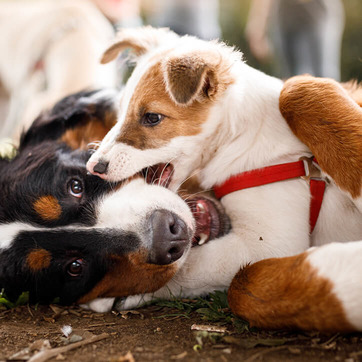Causes of elbow dysplasia (ED)
Although not directly related to hip dysplasia, elbow dysplasia has similar causes. Similar to hip dysplasia (HD), elbow dysplasia (ED) can be attributed to a genetic predisposition. Feeding and exercise influences are also important, as elbow dysplasia develops during growth. It is often associated with young dogs of large and fast-growing breeds, such as German Shepherds or Bernese Mountain Dogs. Elbow dysplasia usually occurs in young dogs because this is the time when the growth in length of the bones progresses the most. During the growth phase, it is therefore essential to avoid overloading, e.g. long walks, frequent stair climbing or jumping. Rapid weight gain, a puppy food too rich in energy and the feeding of additional mineral supplements (especially calcium and vitamin supplements) can favour this development. The genetic influence can only be minimised by healthy breeding and avoiding overloading at a young age.

Diagnosis of elbow dysplasia (ED)
Young dogs often show the first signs of elbow joint dysplasia between the 4th and 7th month of life. The dog reacts sensitively at the elbow, movement restrictions become obvious, the elbow is pressed close to the body due to pain and thus the paw is turned outwards - the dog usually nibbles and licks its painful joint. If elbow/ joint dysplasia is suspected, x-rays often provide reliable information. In certain cases, a computer tomography or an arthroscopy (joint endoscopy) can also be informative.
A defect in the growth zone can cause "radius curvus syndrome" in the forearm bone.
This forearm consists of the two bones ulna and radius. After an injury to the ulna or radius, the bones continue to grow/ at different rates. The consequences can be a visible "knock-kneedness" and instability in the elbow joint. If the ulna and radius no longer fit snugly with the joint of the humerus, this can lead to joint disease.
Lameness, possibly associated with a relieving posture, paws and forearm turned outwards, should therefore, be examined at an early stage by an X-ray diagnosis at the vet.
Manifestations of elbow dysplasia (ED)
The term elbow dysplasia covers three different forms of elbow joint disorders:
OCD (Osteochondrosis dissecans)
OCD is a growth disorder of the articular cartilage. It usually occurs in a part of the body that is subject to particularly high mechanical stress. OCD can therefore occur not only in the elbow but also in the shoulder, knee and ankle joints. In the growth process, the cartilage cells on the joint surfaces and growth plates usually change into bone cells through calcification. If the bones grow too fast, the cartilage layer forms too thick and cannot ossify fast enough, which leads to the death of the cartilage. Cracks can form in the cartilage and sometimes whole cartilage scales can detach. This causes the joint fluid to come into contact with the bone underneath the cartilage, resulting in inflammation of the joint. The accumulation of fluid in the joint stretches the capsule and this causes pain, which in turn can lead to lameness in the dog. The loose cartilage scales usually stay in place, but can also float around as free particles in the joint.

FPC (Fragmented Coronoid Process)
FPC describes an elbow incongruity and affects the bump at the lower end of the crescent of the ulna.
This only ossifies at the age of 4 to 5 months. Different growth in length of the ulna and radius can lead to a step formation in the elbow joint. The hump can break off due to the resulting overload. The joint fluid penetrating into the fracture gap causes inflammation and pain, which manifests itself as lameness and often turns into arthrosis.
IPA (Isolated Processus Anconaeus)
The processus anconaeus is a triangular process at the back of the ulna that helps stabilise the elbow joint. This process is connected to the rest of the bone by a growth plate. This joint should be closed at the age of 4 to 6 months. Delayed growth of the ulna, which therefore can no longer connect with the radius via the articular process (hump), can lead to problems closing the growth plate. In contrast to the FPC, the ulna does not grow properly here. The ossification is not yet complete, although the radius grows perfectly. The hump at the upper end kinks. The joint fluid penetrating the gap inhibits healing and also the ossification of the joint. This leads to painful elbow instability and arthritic changes.
Treatment of elbow dysplasia (ED)
In all manifestations, reluctance to move and lameness are recognisable in affected dogs. Due to inflammation-related reactions in the joint, the pain of the four-legged friend increases during movements. Subsequent arthrosis is usually unavoidable and joint damage cannot be repaired.
However, dogs with the disease should still be exercised in a controlled manner. Walks on the leash, swimming exercises, aqua therapy and physiotherapy should ensure gentle but absolutely necessary muscle development. These therapies and muscle building alleviate the symptoms and can reduce consequential damage, but an operation is still usually unavoidable. Accompanying physiotherapy for pain relief, muscle relaxation of the overstrained structures and gentle muscle building after the operation is particularly promising.
The dog owner can take some additional measures to enable the dog to enjoy more exercise and quality of life. To support the musculoskeletal system and joint processes as well as to reduce inflammation, supplementary feeds with joint-active, high-dose ingredients such as omega-3 fatty acids, vitamin E, green-lipped mussel, chondroitin, devil's claw and collagen Il can be given at any age.

